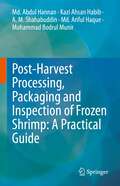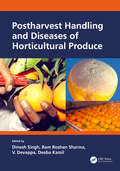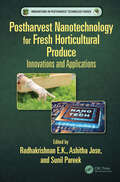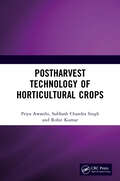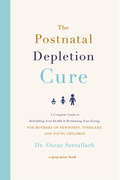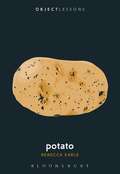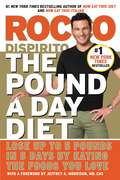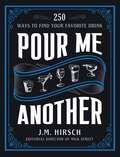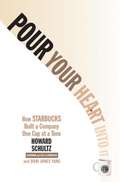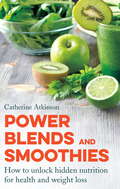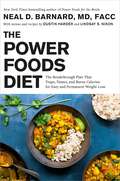- Table View
- List View
Posh Nosh: Delicious Recipes That Will Impress Your Guests
by Good Housekeeping InstituteGood Housekeeping recipes tick all the boxes – They look greatThey taste deliciousThey’re easy to make
Post-Harvest Processing, Packaging and Inspection of Frozen Shrimp: A Practical Guide
by Md. Abdul Hannan Kazi Ahsan Habib A. M. Shahabuddin Md. Ariful Haque Mohammad Bodrul MunirThe book is a practical guide for the various steps in the post-harvest technology of frozen shrimps. Shrimps are one of the most common and popular types of seafood consumed globally. The book discusses some of the most sought-after shrimps such as Penaeus monodon, P. vannamei, and Macrobrachium rosenbergii. Good-quality shrimp is a prerequisite for the seafood business as it is used for human consumption. Lack of proper knowledge in raw materials handling and post-harvest processing is the main obstacle in quality shrimp production. Complex business policy, commitment break in both parties (buyers and sellers), competition with other seafood-producing countries, and fluctuation of currency in international seafood market are the factors affecting international seafood business. This book closes this gap in literature and facilitates the production of excellent-quality exportable frozen shrimp through informed practices from experts. The book includes information about packaging of frozen shrimp, inspection, and shipment. It also compiles different mathematical calculations which are in practiced in the processing industries. The book is essential reading for professionals in the shrimp producing and processing industries. It is also useful for researchers in fisheries science, aquaculture, food technology, and food microbiology.
Post-Intensive Care Syndrome (Lessons from the ICU)
by Jean-Charles Preiser Margaret Herridge Elie AzoulayThis book, part of the European Society of Intensive Care Medicine textbook series, provides detailed up-to-date information on the physical, cognitive, and psychological impairments that are frequently present following a stay in an intensive care unit and examines in depth the available preventive and therapeutic strategies, including adapted rehabilitation programs. Beyond acquainting readers with the multiple facets of post-intensive care syndrome (PICS), the book aims to promote the effective follow-up of patients, thereby enhancing their ability to work and their functional autonomy, and to identify risk factors for the development of PICS as a stimulus to beneficial organizational changes in intensive care departments.The background to the book is the realization by healthcare providers that the quality of life of patients who have required a stay in an intensive care unit can be severely impaired or even become unacceptable. All too often, the diverse sequelae are overlooked by specialists of other disciplines. Moreover, families and caregivers are also at high risk of post-traumatic stress disorder and depression. The European Society of Intensive Care Medicine has developed the Lessons from the ICU series with the vision of providing focused and state-of-the-art overviews of central topics in Intensive Care and optimal resources for clinicians working in Intensive Care. This book, written by renowned experts in the field, will facilitate the transmission of key knowledge with significant clinical and financial benefits.
Post-Natal Health: Natural remedies, advice and exercises for common mother and baby complaints (Wellbeing Quick Guides)
by Liz EarleLiz Earle teaches you everything you need to know to care for your baby and your body after becoming a mother, from breast-feeding and baby massage to supplements and aromatherapy.Bestselling beauty and wellbeing writer Liz Earle's fully revised and updated quick guide to post-natal health, including:- Safe, effective exercises for after the birth- Advice on the breast-feeding and infant weaning- How to cope with your physical changes- The baby blues: what to do- Supplements and herbal remedies for everyday problems- Post-pregnancy aromatherapy and baby massage
Postal Bakes: Over 60 cakes, cookies and other treats to send by mail
by Lucy BurtonIn Postal Bakes, Lucy Burton shares over 60 simple yet decadent recipes made to be sent through the post – all using the same tin. Featuring an array of fudgy brownies, sharing cookie slabs, sponge cakes, indulgent truffles and more, there is something to please even the most discerning sweet tooth. Lucy also shares how to pack baked goods so they look beautiful and arrive in one piece.So, whether it's a birthday, get-well-soon, new home or 'just because', make someone's day by posting them a homemade treat.
Postharvest Handling and Diseases of Horticultural Produce
by Dinesh SinghPostharvest Handling and Diseases of Horticultural Produce describes all the postharvest techniques, handling, pre-cooling, postharvest treatment, edible coating and storage of the horticultural produce available to handle perishable horticultural food commodities, covering the areas of horticulture, agricultural process engineering, postharvest technology, plant pathology and microbiology. Postharvest diseases of major fruits and vegetables, with their causal agents, are described. The integrative strategies for management of postharvest diseases include effectively inhibiting the growth of pathogens, enhancing the resistance of hosts and improving environmental conditions, with results that are favourable to the host and unfavourable to the pathogen growth including biotechnological approaches. Adopting a thematic style, chapters are organized by type of treatment, with sections devoted to postharvest risk factors and their amelioration. The chapters are written by experts in the fields of plant pathology, horticulture, food science etc., and core insights into identifying and utilizing appropriate postharvest options for minimizing postharvest losses and enhancing benefits to end-users are provided. Features Presents the most recent developments in the field of postharvest handling technologies and diseases in a single volume Includes postharvest diseases of cut flowers, fruits, vegetables and tuber crops. Appropriate for students, researchers and professionals Written by experts and can be used as a reference resource
Postharvest Handling and Diseases of Horticultural Produce
by Dinesh Singh Ram Roshan Sharma V. Devappa Deeba KamilPostharvest Handling and Diseases of Horticultural Produce describes all the postharvest techniques, handling, pre-cooling, postharvest treatment, edible coating and storage of the horticultural produce available to handle perishable horticultural food commodities, covering the areas of horticulture, agricultural process engineering, postharvest technology, plant pathology and microbiology. Postharvest diseases of major fruits and vegetables, with their causal agents, are described. The integrative strategies for management of postharvest diseases include effectively inhibiting the growth of pathogens, enhancing the resistance of hosts and improving environmental conditions, with results that are favourable to the host and unfavourable to the pathogen growth including biotechnological approaches. Adopting a thematic style, chapters are organized by type of treatment, with sections devoted to postharvest risk factors and their amelioration. The chapters are written by experts in the fields of plant pathology, horticulture, food science etc., and core insights into identifying and utilizing appropriate postharvest options for minimizing postharvest losses and enhancing benefits to end-users are provided. Features Presents the most recent developments in the field of postharvest handling technologies and diseases in a single volume Includes postharvest diseases of cut flowers, fruits, vegetables and tuber crops. Appropriate for students, researchers and professionals Written by experts and can be used as a reference resource
Postharvest Nanotechnology for Fresh Horticultural Produce: Innovations and Applications (Innovations in Postharvest Technology Series)
by Radhakrishnan E. K. Ashitha Jose Sunil PareekFood scarcity and insecurity is an alarming issue throughout the world. Postharvest loss due to both mechanical damage and microbial spoilage significantly influences the shelf life and hence the availability of agricultural produce. Once initiated, the microbial spoilage can make bulk quantity of a given agricultural product unacceptable for human consumption, and several methods have already been used to try to manage this. Considering the limited success of the available methods, there is increasing interest in exploring nanotechnological methods. These methods are being considered for both the development of various platforms for antimicrobial/barrier packaging applications that minimize the contact of agricultural produce with the external environment, and also for design sensors to ensure food safety and quality. The impact of various nano-systems developed through material engineering on the shelf-life enhancement and storage of fresh horticultural produce will have revolutionary effects on post-harvest management in the coming years. Hence, Postharvest Nanotechnology for Fresh Horticultural Produce has been edited to advance understanding of material development, intelligent selection of nanomaterials to ensure the nontoxic nature, and future perspectives of nanotechnology on postharvest produce. This includes various types of nanoparticles exploited for the postharvest management, their mechanism of action, varied applications and material engineering, along with natural products including essential oils and plant bioactives, modelling of various tailor-made materials to meet the required properties of the packed food, advancements in the nanotechnological applications for the minimally processed food, and the toxicity concerns. Key Features: · Describes advances in nanotechnology for postharvest management · Includes extensive details on the applications of material engineering for post-harvest applications using nanotechnology and future aspects · Provides extensive data on the types of nanomaterials used and the fabrication methods employed for the design of tailor-made products for the post-harvest management This book reviews the current scientific advancements and future prospects of the nanotechnological interventions in meeting the quality and quantity standards of the horticultural produce and minimally processed food and will be a valuable reference for beginners, researchers, subject experts, and industrialists.
Postharvest Nanotechnology for Fresh Horticultural Produce: Innovations and Applications (Innovations in Postharvest Technology Series)
Food scarcity and insecurity is an alarming issue throughout the world. Postharvest loss due to both mechanical damage and microbial spoilage significantly influences the shelf life and hence the availability of agricultural produce. Once initiated, the microbial spoilage can make bulk quantity of a given agricultural product unacceptable for human consumption, and several methods have already been used to try to manage this. Considering the limited success of the available methods, there is increasing interest in exploring nanotechnological methods. These methods are being considered for both the development of various platforms for antimicrobial/barrier packaging applications that minimize the contact of agricultural produce with the external environment, and also for design sensors to ensure food safety and quality. The impact of various nano-systems developed through material engineering on the shelf-life enhancement and storage of fresh horticultural produce will have revolutionary effects on post-harvest management in the coming years. Hence, Postharvest Nanotechnology for Fresh Horticultural Produce has been edited to advance understanding of material development, intelligent selection of nanomaterials to ensure the nontoxic nature, and future perspectives of nanotechnology on postharvest produce. This includes various types of nanoparticles exploited for the postharvest management, their mechanism of action, varied applications and material engineering, along with natural products including essential oils and plant bioactives, modelling of various tailor-made materials to meet the required properties of the packed food, advancements in the nanotechnological applications for the minimally processed food, and the toxicity concerns. Key Features: · Describes advances in nanotechnology for postharvest management · Includes extensive details on the applications of material engineering for post-harvest applications using nanotechnology and future aspects · Provides extensive data on the types of nanomaterials used and the fabrication methods employed for the design of tailor-made products for the post-harvest management This book reviews the current scientific advancements and future prospects of the nanotechnological interventions in meeting the quality and quantity standards of the horticultural produce and minimally processed food and will be a valuable reference for beginners, researchers, subject experts, and industrialists.
Postharvest Pathology: Next Generation Solutions to Reducing Losses and Enhancing Safety (Plant Pathology in the 21st Century #11)
by Davide Spadaro Samir Droby Maria Lodovica GullinoThe book will address selected topics in postharvest pathology aiming at highlighting recent development in the science, technology and control strategies of postharvest diseases to reduce losses and enhance safety of harvested agricultural products. Topics will include: 1) Introduction: Perspectives and challenges in postharvest pathology 2) Elucidating host-pathogen interactions 3) Next generation technologies for management and detection of postharvest pathogens 4) Food safety in postharvest pathology 5) Alternative postharvest diseases control strategies 6) Chemical control of postharvest diseases
Postharvest Technology of Horticultural Crops
by Priya Awasthi Subhash Chandra Singh Rohit KumarThis book is an informative introduction to the post-harvest technology of horticultural crops, and their conservation and management. The different post-harvest handling operations including storage aspects are also covered. Innovative processing technologies like high-pressure processing, irradiation, cold plasma technique and ohmic heating are also discussed in the book.
Postharvest Technology of Horticultural Crops
by Priya Awasthi Subhash Chandra Singh Rohit KumarThis book is an informative introduction to the post-harvest technology of horticultural crops, and their conservation and management. The different post-harvest handling operations including storage aspects are also covered. Innovative processing technologies like high-pressure processing, irradiation, cold plasma technique and ohmic heating are also discussed in the book.
The Postnatal Depletion Cure: A Complete Guide To Rebuilding Your Health And Reclaiming Your Energy For Mothers Of Newborns, Toddlers And Young Children
by Dr Oscar SerrallachIt's all too common to hear new mums talk about 'baby brain' and extreme fatigue. But what if it wasn't the physical toll of giving birth, breastfeeding or chasing a toddler that was sapping your strength? What it if was something deeper? Dr. Oscar Serallach has spent his medical career witnessing women fail hormonally, nutritionally and emotionally to get back on their feet after having a baby. The true cause? A syndrome he calls postnatal depletion. THE POSTNATAL DEPLETION CURE is the first book to name the syndrome and to offer a practical programme to help mothers replenish their bodies after having a baby. The book includes a comprehensive guide to the nutrients women need to enhance organ function and balance hormones, along with advice on how to maintain a healthy diet and exercise routine and get necessary rest, despite the demands of motherhood. Filled with prescriptive takeaways and many success stories, THE POSTNATAL DEPLETION CURE will help mothers be the best they can be physically and emotionally.
Potato (Object Lessons)
by Rebecca EarleObject Lessons is a series of short, beautifully designed books about the hidden lives of ordinary things.Baked potatoes, Bombay potatoes, pommes frites . . . everyone eats potatoes, but what do they mean? To the United Nations they mean global food security (potatoes are the world's fourth most important food crop). To 18th-century philosophers they promised happiness. Nutritionists warn that too many increase your risk of hypertension. For the poet Seamus Heaney they conjured up both his mother and the 19th-century Irish famine. What stories lie behind the ordinary potato? The potato is entangled with the birth of the liberal state and the idea that individuals, rather than communities, should form the building blocks of society. Potatoes also speak about family, and our quest for communion with the universe. Thinking about potatoes turns out to be a good way of thinking about some of the important tensions in our world. Object Lessons is published in partnership with an essay series in The Atlantic.
Potato: The Politics Of The Potato (Object Lessons)
by Rebecca EarleObject Lessons is a series of short, beautifully designed books about the hidden lives of ordinary things.Baked potatoes, Bombay potatoes, pommes frites . . . everyone eats potatoes, but what do they mean? To the United Nations they mean global food security (potatoes are the world's fourth most important food crop). To 18th-century philosophers they promised happiness. Nutritionists warn that too many increase your risk of hypertension. For the poet Seamus Heaney they conjured up both his mother and the 19th-century Irish famine. What stories lie behind the ordinary potato? The potato is entangled with the birth of the liberal state and the idea that individuals, rather than communities, should form the building blocks of society. Potatoes also speak about family, and our quest for communion with the universe. Thinking about potatoes turns out to be a good way of thinking about some of the important tensions in our world. Object Lessons is published in partnership with an essay series in The Atlantic.
Potato Breeding: Theory and Practice
by John E. BradshawThe potato (Solanum tuberosum) is the world’s fourth most important food crop after maize, rice and wheat with 377 million tonnes fresh-weight of tubers produced in 2016 from 19.2 million hectares of land, in 163 countries, giving a global average yield of 19.6 t ha-1 (http://faostat.fao.org). About 62% of production (234 million tonnes) was in Asia (191), Africa (25) and Latin America (18) as a result of steady increases in recent years, particularly in China and India. As a major food crop, the potato has an important role to play in the United Nations “2030 Agenda for Sustainable Development” which started on 1 January 2016 (http://faostat.fao.org). By 2030 the aim is to “ensure access by all people, in particular the poor and people in vulnerable situations, including infants, to safe, nutritious and sufficient food all year round”. By then, the world population is expected to reach 8.5 billion and continue to increase to 9.7 billion in 2050. For potatoes, theneed is to increase production and improve nutritional value during a period of climate change, a key aspect of which will be the breeding of new cultivars for a wide range of target environments and consumers.The aim of the book is to help this endeavour by providing detailed information in three parts on both the theory and practice of potato breeding. Part I deals with the history of potato improvement and with potato genetics. Part II deals with breeding objectives, divided into improving yield, quality traits and resistance to the most important diseases and pests of potatoes. Part III deals with breeding methods: first, the use of landraces and wild relatives of potato in introgression breeding, base broadening and population improvement; second, breeding clonally propagated cultivars as a way to deliver potato improvement to farmers’ fields; third, as an alternative, breeding potato cultivars for propagation through true potato seed; and fourth, gene editing and genetic transformation as ways of making further improvements to already successful and widely grown cultivars. Included are marker-assisted introgression and selection of specific alleles, genomic selection of many unspecified alleles and diploid F1 hybrid breeding.
Potions: A Guide to Cocktails, Tinctures, Tisanes, and Other Witchy Concoctions
by Nikki Van De CarFrom Nikki Van De Car, the best-selling author of Practical Magic, comes a fully-illustrated, enchanted introduction to the witch's world of modern potions, including tinctures, infusions, herbal DIYs, and magically-infused craft cocktails.Witchcraft meets cocktail craft in Potions, a contemporary introduction to the world of infusions, tisanes and herbal teas, homemade tinctures, and expertly mixed alcoholic beverages, all imbued with a healthy dose of everyday enchantment. As with all magic, intention is what makes a potion a potion, and author Nikki Van De Car uses her signature blend of holistic remedies, DIY projects, and accessible magical rituals to guide readers through the wide world of potion-making. From homebrewed kombuchas to crystal-charged cocktails, this fully illustrated guide is an essential addition to the arsenal of kitchen witches and enchanted mixologists. Organized around a series of intentions -- including Creativity, Calm, Love, Harmony, and Protection -- the chapters in this book each include teas, cocktails, kombuchas, non-alcoholic beverages, and DIY components like bitters, shrubs, and infusions, that enhance the reader's spellwork. Every recipe will involve a brief ritual of some kind, whether setting an intention, or using a crystal, sun magic, or moon magic, and each recipe will involve some form of herbal magic. Each cocktail is accompanied by a vibrant, full-color illustration, and each chapter includes longer mystical rituals to support the reader&’s overall magical practice.
Potty!: Clarissa's One Pot Cookbook
by Clarissa Dickson WrightPerfect for anyone who loves good food but hates washing up, provides tried-and-tested recipes for spectacular yet simple dishes from one of Britain's best-loved food writers.
The Pound a Day Diet: Lose Up to 5 Pounds in 5 Days by Eating the Foods You Love
by Rocco DiSpiritoTHE POUND A DAY DIET is an accelerated program designed to help dieters lose up to five pounds every five days-- without frustrating plateaus-- while enjoying all their favorite foods. It rewrites every carb/fat/calorie rule in the book! This delicious, easy-to-use, plan is specifically formulated as a Mediterranean-style diet that is carb and calorie corrected to turbocharge metabolism and weight loss. Complete with menus for 28 days (four five-day plans and four weekend plans), dieters first follow the five-day plan, switch over to the weekend plan, return to the five-day plan for the second week, and continue with the weekend plan-alternating like this right down to their goal weight. To help readers, Rocco has created 50 all-new lightning-quick 5 ingredient recipes, as well as ready-made suggestions for those who simply cannot find the time to cook; a primer on healthy and fast cooking techniques; calorie-calibrated menus and shopping lists; and a lifestyle plan for maintaining a lean, healthy body for life.
The Pound a Day Diet: Lose Up to 5 Pounds in 5 Days by Eating the Foods You Love
by Rocco DiSpiritoThe Pound a Day Diet is an accelerated program designed to help dieters lose up to five pounds every five days-- without frustrating plateaus-- while enjoying all their favorite foods. It rewrites every carb/fat/calorie rule in the book! This delicious, easy-to-use, plan is specifically formulated as a Mediterranean-style diet that is carb and calorie corrected to turbocharge metabolism and weight loss. Complete with menus for 28 days (four five-day plans and four weekend plans), dieters first follow the five-day plan, switch over to the weekend plan, return to the five-day plan for the second week, and continue with the weekend plan-alternating like this right down to their goal weight. To help readers, Rocco has created 50 all-new lightning-quick 5 ingredient recipes, as well as ready-made suggestions for those who simply cannot find the time to cook; a primer on healthy and fast cooking techniques; calorie-calibrated menus and shopping lists; and a lifestyle plan for maintaining a lean, healthy body for life.
Pour Me Another: 250 Ways to Find Your Favorite Drink
by J. M. HirschChoose your own cocktail adventure: Use the drinks you already love to explore a world of delicious new spirits, combinations, and flavors. You know what you like to drink—but what&’s next? Expert mixologist and James Beard Award-winning editorial director of Milk Street J.M. Hirsch has the answer in Pour Me Another, where every recipe helps you choose your next drink. Consider the rum Mojito. If that&’s your go-to, you might not consider yourself a bourbon drinker. But a whiskey Mint Julep delivers many of the same refreshing, minty notes. And from there it&’s a short jump to a vodka Mint Fizz, which livens things up with lemon and almond syrup. Or maybe you&’re a bourbon Old Fashioned drinker. Pour Me Another guides you to a gin Bijou, which brings in Manhattan-like notes. Then try a Vieux Carré, with herbal notes atop peppery rye. Soon you&’re sipping a Mexican Vieux Carré, which uses tequila for a similar rich and spicy effect. If a Gin & Tonic is more your speed, head toward tropical territory with a gingery Lime in de Coconut. Like that one? Go for a Coconut-Lime Daiquiri next. Everyone loves a Margarita, but have you tried the Manhattan-inspired La Rosita? Discover the versatility of vodka with a cousin to the Martini, in the botanical Stupid Cupid. No matter your taste or liquor of choice, Pour Me Another guides you to a new world of drinks you&’ll love. It&’s an essential handbook for cocktail lovers and home mixologists everywhere.
Pour Your Heart Into It: How Starbucks Built a Company One Cup at a Time
by Howard SchultzIn Pour Your Heart Into It, former CEO and now chairman emeritus Howard Schultz illustrates the principles that have shaped the Starbucks phenomenon, sharing the wisdom he has gained from his quest to make great coffee part of the American experience. The success of Starbucks Coffee Company is one of the most amazing business stories in decades. What started as a single store on Seattle's waterfront has grown into the largest coffee chain on the planet. Just as remarkable as this incredible growth is the fact that Starbucks has managed to maintain its renowned commitment to product excellence and employee satisfaction. Marketers, managers, and aspiring entrepreneurs will discover how to turn passion into profit in this definitive chronicle of the company that "has changed everything... from our tastes to our language to the face of Main Street" (Fortune).
Power Blends and Smoothies: How to unlock hidden nutrition for weight loss and health
by Catherine AtkinsonUse the recipes in this book to turbo-charge your body and mind with freshly made smoothies and blends that are bursting with health-giving vitamins, minerals, phytonutrients and antioxidants. It will help you get the most out of using your power blender and enable you to incorporate healthy habits into your hectic life with ease.Each of the nearly 150 recipes includes delicious and beneficial fruit and vegetable super foods: Health Improvers: detoxers, brain boosters, antioxidants, mood lifters, and more;Weight Busters: get slim with protein packers, natural juices, dried fruits - and raw chocolate!;Exercise Enhancers: recipes to increase oxygenation, bone density, and muscle strength;Beauty Boosters: enjoy clear eyes and healthy skin, and slow the ageing process.Power Blending and Juicing provides simple, quick and easy ways to get much more than your daily requirement of healthy fruit and vegetables. Use the recipes to create goodness in a glass, with a range of blends and smoothies that are packed with nutrients - and utterly delicious.
The Power Foods Diet: The Breakthrough Plan That Traps, Tames, and Burns Calories for Easy and Permanent Weight Loss
by Neal BarnardDr. Neal Barnard&’s new diet and plan offers an evidence-based, food-as-medicine protocol for kickstarting weight loss and keeping it off. Eat These Foods, Lose the Weight Weight loss is one of our top health concerns, so much so that we keep looking for good ways to lose weight, preferably a way that is easy, effective, and permanent. It turns out that, when properly chosen, certain foods cause weight loss, with no need for the deprivation and planning that most weight-loss regimens require. In his next book, leading nutrition researcher and author Dr. Neal Barnard reveals three breakthroughs that are supported by research, revealing that certain foods: 1. can reduce the appetite 2. trap calories so they are flushed away and cannot be absorbed, and, 3. increase the body&’s ability to burn calories for about three hours after each meal. These breakthroughs make weight loss incredibly easy, without calorie counting or deprivation. This diet encourages people to eat, not to stop eating. Dr. Barnard also reveals that some of the foods we think are good for us can actually be harmful, like salmon, goat cheese, and coconut oil, all of which pass easily into body fat...and often overstay their welcome. To make it easy, Dr. Barnard will include a simple to follow meal plan that includes delicious, and even indulgent recipes which include foods we have often been told to avoid, like potatoes and pasta, so you can eat real food, and still lose real weight.
Power Grains: Spelt, farro, freekeh, amaranth, kamut, quinoa and other Ancient grains
by Ryland Peters SmallOver 25 delicious recipes that make introducing Ancient grains to your diet a doddle. Move over wheat, there’s a new grain in town. In fact there are many. A whole host of power grains are now available to us that can improve our general health and well-being. Packed full of dietary fibre and plant-based proteins, and rich in vitamins and minerals, these ‘superfood’ grains boost energy levels, keep you feeling fuller for longer and can help improve your appearance from the inside out. Recipes to try include ideas for breakfast bowls and bars, soups and salads, larger plates and both savoury and sweet bakes. Discover Power Protein Granola; Peach & Chia Smoothies; Freekeh, Pumpkin & Crispy Ginger Salad; Roast Asparagus & Farro Soup; Spicy Quinoa Burgers with Portobello Mushrooms; Saffron Shrimp Barley Pilaf; Stuffed Trout with Faro, Dates & Pine Nuts; or indulge in a slice of Fresh Blueberry Tart with Spelt Crust or a Peanut Butter & Quinoa Cookie. Whether you need early morning fuel food to prepare you for the day ahead, a lunchtime brain boost at work, or a protein fix ahead of an energetic evening workout, you’ll find easy and delicious ideas for any time of the day here in Power Grains.

